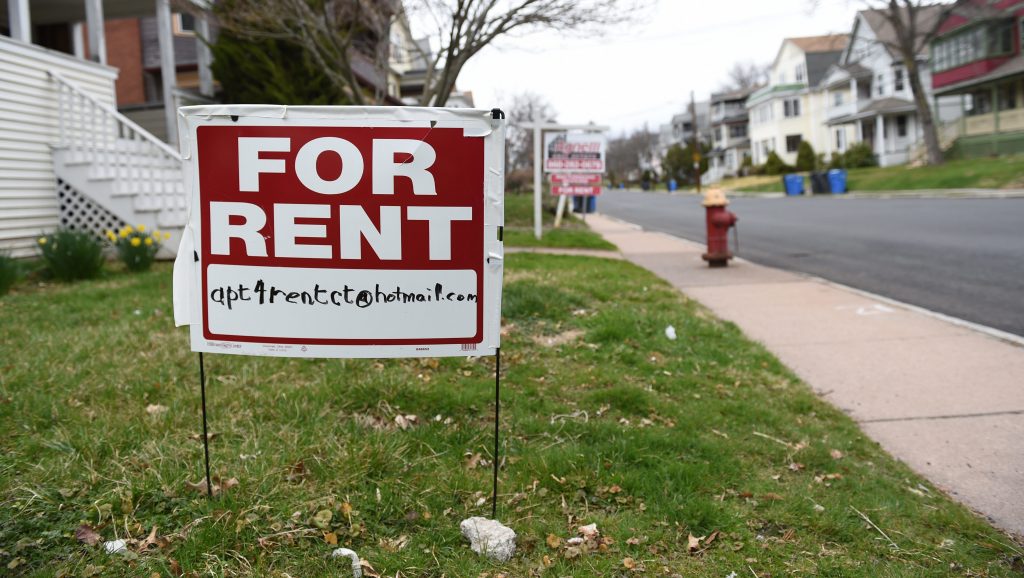Lamont Says Social Distancing is Working, but CT’s COVID-19 Peak Still Lies Ahead

Audio By Carbonatix

Gov. Ned Lamont provides a briefing on COVID-19 on April 8, 2020. Screenshot from CT-N
State officials said the rate at which the coronavirus is spreading seems to be slowing down. West Hartford had its largest increase in positive cases on Wednesday.
By Jacqueline Rabe Thomas, and Gregory B. Hladky, CTMirror.org
Connecticut’s official coronavirus death toll rose by another 58 people Wednesday, bringing the state’s total since the start of the pandemic to 335, the state announced Wednesday. The number of people hospitalized for COVID-19 increased by 110 to a current total of 1,418.
The state saw a spike in the number of COVID-19 deaths earlier in the week with 71 people dying on Tuesday alone, and the southern part of the state remains part of the disease’s tri-state area epicenter. But Wednesday’s numbers were far less severe in Connecticut as a whole, and experts say they now expect the pandemic to peak in the state in late April or early May.
“I think the social distancing is working,” the governor said, suggesting the coronavirus “is perhaps not going as fast” as previous models had predicted.
There are currently 8,781 people with confirmed COVID-19 diagnoses in Connecticut.
In West Hartford, the total number of confirmed positive cases of COVID-19 spiked by 15 Wednesday, from 51 to a total of 66. Wednesday’s numbers were released late in the day and demographic information was not immediately available from the West Hartford-Bloomfield Health District.
Earlier Wednesday, Dr. Ajay Kumar, executive vice president and chief clinical officer for Hartford HealthCare, also said current data on the spread and intensity of the virus in Connecticut indicates that “the peak or rate of increase has been delayed.” He too said it appears to be the result of social distancing.

But Kumar warned that “outbreaks in [nursing homes] can change our numbers drastically.” He said the peak in this state is now expected to hit in late April and early May. Experts say COVID-19 infections can be expected to double every three to five days.
Lamont said that 39% of Connecticut nursing homes now have at least one resident infected with the virus. Other state officials added that two nursing homes will be converted to care for coronavirus patients, and two other sites will provide additional beds for alternative care for nursing home residents.
In an email Wednesday night the governor’s office provided a list of all nursing homes in the state with at least one resident who has tested positive for COVID-19. The list included three facilities in West Hartford: Hebrew Center for Health & Rehabilitations, St. Mary Home, and West Hartford Health and Rehabilitation.
Unemployment claims still outpace the state’s ability to process them
Labor Commissioner Kurt Westby said his agency sent out more than $35 million in unemployment benefits to nearly 104,000 people during last week.
Westby said the state is working hard to process the 302,000 new unemployment claims that have been submitted since March 13 and that approximately 132,000 of those claims have now been processed. Westby said the “tsunami of claims” amounts to about two years’ worth of what the department would receive under normal circumstances. He now has 80 people working on the backlog, he said, and is authorizing overtime and weekend work to help clear it.
The wait for people now filing through the state’s outdated computer system is about five weeks before they can see any unemployment checks, but Westby said his agency is putting in two “fixes” that should “drastically reduce that backlog.”
New CVS sites will help ramp up testing
Questioned about reports that some ill people around the state have been turned away from outpatient COVID-19 testing sites, Lamont said his administration is “ramping up testing capacity dramatically.” He cited a new agreement with CVS that will result in two big new testing sites being opened up in New Haven and Stamford within the next two weeks.
Those sites are expected to be able to test as many as 1,000 people a day, and they’ll use a new technology to get results back in as little as 15 minutes, officials said.
Kumar said testing around the state is still being limited by test kit shortages and other materials needed to transport or process samples.
“We should be having a lot more tests,” Kumar said.
Lamont acknowledged that in addition to testing shortages, lack of personal protective equipment for frontline medical workers continues to be an issue around the state. Josh Geballe, the governor’s top administrative officer, said Connecticut “received a significant shipment of masks today” and expects to see “a significant influx of PPE” over the next few days.
“We are going to get that gear out as fast as we possibly can,” Lamont said.
Big-city leaders seek rent protections for hard-hit residents

“For Rent” sign hangs in front of a house in Hartford’s West End. Courtesy CTMirror.org
Connecticut’s big-city mayors Wednesday called on Lamont and legislative leaders to help their constituents who are struggling to pay rent while out of work during the coronavirus pandemic.
Lamont said at his briefing that he expects within the next 24 hours to issue a new executive order dealing with protection for renters, but it was unclear exactly what that executive order would do.
“Many working people across Connecticut can’t afford to miss even a few days of work,” the mayors from Bridgeport, Hartford, New Haven, Middletown, Norwalk and Stamford wrote to state lawmakers Tuesday. “Our communities are likely to be disproportionately affected by the economic impact of coronavirus and our response to coronavirus, as many of our residents work non-salaried, hourly jobs to pay their bills. We need to make sure those families don’t lose their housing.”
Mortgage relief disproportionately benefits residents in Connecticut’s more affluent communities. For example, in Fairfield, 83% of the residents owned their homes, compared to 24% in Hartford. Renters’ income is typically less than half of homeowners.
In their letter, the coalition of mayors point out that the governor has the authority to override state laws to help renters during a public health emergency, and ask legislative leaders to step in and adopt robust housing protections.
Those protections include giving renters 90 days after the public health emergency ends to pay the missed rent, as long as half of any amount owed is paid back within the first 30 days of when the emergency ends. The mayors also want the state to give tenants who make partial payment of back rent within 30 days after the emergency ends another 60 days to catch up on their rent and keep their housing.
They also want to solidify in state law eviction protections Lamont ordered last month for any future public health emergencies.
The mayors write this will help ensure that “none of our neighbors are evicted just because they can’t work during a public health emergency, while still making sure that landlords can collect full rent once the emergency is over. … Keeping people in their homes is the right thing to do – from a public health perspective and from a humanitarian perspective.”
The governor and the Judicial Branch has already ordered judges not to issue any evictions of tenants, but that has not stopped landlords from filing the paperwork for judges to hear their case when the courts reopen.
During the first 14 days that the courts stopped hearing these requests to evict, 516 families have had lawsuits filed against them, court filings show.
While the protection from being thrown out of their rental homes during the pandemic protects people from becoming homeless now, tenants are still legally on the hook for paying rent even with the courts closed – and can face eviction when courts reopen for any rent they are unable to pay. The court filings also impact tenants’ credit scores.
Earlier this week, the Lamont administration’s website highlighting the state’s effort to address the pandemic was updated to outline more aggressive measures the administration was taking to help renters:
“… Governor Lamont has ordered that owners and lessors of residential and commercial properties may not evict or initiate an eviction until thirty days after the end of the public health and civil preparedness emergency. Owners and lessors must withdraw and/or rescind any action initiated since March 10, 2020. The order does not apply to owners of residential property of two units if the owner lives in one unit of the property and the owner believes the tenant is a serious nuisance.”
These actions, however, have not yet been implemented, and were taken down after the Hartford Business Journal asked about them. Lamont spokesman Max Reiss told the publication that the administration was working on additional rental protections, but he declined to provide further details.
“The administration has been working on steps to assist renters during this unprecedented public health crisis and our hope is to have those announced before the end of the week,” Reiss said.
Municipalities ask Lamont to share federal funds
The governor is also being pressed by another group – Connecticut’s cash-strapped cities and towns.
The Connecticut Conference of Municipalities wrote to Lamont on Tuesday, asking him to commit to sharing a portion of the federal relief program. Specifically, municipal leaders asked Lamont to begin discussions immediately to resolve the state’s share of the Coronavirus Relief Fund, which one policy group estimated at nearly $1.4 billion.
At issue is the $150 billion Coronavirus Relief Fund enacted by Congress as part of the $2 trillion Coronavirus Aid, Relief, and Economic Security Act enacted by Congress in March. Connecticut’s estimated share of those funds, $1.38 billion according to the National Conference of State Legislatures, is supposed to provide relief to state, municipal and tribal governments.
Caught between shrinking tax receipts and unstable borrowing options, municipalities pressed the governor to “provide meaningful state CARES funding to cities and towns,” wrote CCMC Executive Director Joe DeLong in a letter released to the media Wednesday,
And while municipal leaders here acknowledge Lamont can do what he wants with those dollars – at least until the legislature is back in session – they say that Congress clearly intended communities to get some.
“We feel there is a very clear intent that communities share in that,” DeLong said.
Connecticut legislator describes having COVID-19
A Connecticut legislator who was infected with COVID-19 said Monday she’s finally on the road to recovery.
Jane Garibay, D-Windsor, said she was in one of the first groups of people to test positive for the virus back in mid-March. Her sister also contracted the disease.
Garibay told Connecticut Public Radio’s Lucy Nalpathanchil the diagnosis was scary because there is so much to learn about coronavirus – and its potential impacts on people with pre-existing conditions.
“I’m a breast cancer survivor. It will be a year in May. And I am cancer free, so I had that,” Garibay said. “I am a Type 2 diabetic – I’m not on insulin – so that was another risk factor. And I am 64. So, given all that, I think I did pretty well.”
Garibay said she was sick for over two weeks with a dry cough and a fever that topped 103 degrees. She also had other symptoms.“The aches and pains like you get in the flu – only ten times [worse],” Garibay said. “I felt like they were ripping my legs out of my hips … so the symptoms were pretty strong and painful.”
On Friday, Garibay said she got good news: a letter from her local health department, which said she’d been fever-and-symptom free for long enough to get her life back to normal. Garibay said now she’ll do shopping for people who need it so they can stay home.
Recovered COVID-19 patients asked to donate blood plasma
A new program is being developed by several hospitals in southwestern Connecticut to accept blood plasma donated by people who have already recovered from COVID-19, with the plasma to be used to help critically ill coronavirus patients.
The idea is that those donors’ blood plasma contains antibodies that could help patients who are still fighting the virus, according to officials at Nuvance Health.
Nuvance is a medical network that includes hospitals in Danbury, New Milford, Norwalk, Sharon, and several area New York medical facilities. New York and neighboring Fairfield County in Connecticut are part of the epicenter of the pandemic in the northeast.
Dr. Ajay Kumar, executive vice president and chief clinical officer for the Hartford HealthCare system, said Wednesday his institution is also investigating the use of blood plasma from recovered COVID-19 patients. But he also stressed that this “is still an experimental therapy” and that a cautious approach to its use is needed.
“We will have the capability very soon, actually this week,” Kumar said of the blood plasma therapy, adding Hartford HealthCare is still seeking suitable donors for trials with coronavirus patients.
Nuvance officials said they are currently recruiting volunteers who have recovered from the coronavirus and asking them to register by filling out an online questionnaire at https://veoci.com/veoci/p/form/d9keubfc4gca.
Under U.S. Food and Drug Administration guidelines, a donor must have had a positive COVID-19 test and be symptom-free for at least 14 days with a negative coronavirus test. People who have tested positive for the virus and have been symptom-free for 28 days could be donors even without a negative follow-up test.
After a person registers by filling out the questionnaire a member of the Nuvance Health plasma team will contact the potential donor.
Veterans’ groups urge quicker release of inmates at risk from virus
A coalition of veterans’ groups fearful of the impact of COVID-19 on Connecticut prisons called on Gov. Lamont Wednesday to immediately release certain veterans and other vulnerable inmates who are currently incarcerated.
The veterans’ groups are the latest in a series of organizations demanding the swift release of inmates from state prisons who could be in danger from the spread of the coronavirus through corrections facilities.
“COVID-19 will spread like wildfire through Connecticut prisons,” Garry Monk, executive director of the National Veterans Council for Legal Redress, said in a statement released Wednesday. Ten other veterans’ and advocacy groups joined in the letter sent to Lamont.
“It is imperative that Connecticut follow the lead of states like California, New York, and New Jersey and begin safely reducing the population of Connecticut prisons,” Monk said.
Connecticut veterans said they are particularly worried about inmates at the Willard-Cybulski Correctional Institution in Enfield, which is the only state prison with a Veterans’ Services Unit.
Earlier this week, state Corrections Commissioner Rollin Cook said his department has been releasing non-violent older inmates and others who may be at high risk from the virus. He said Connecticut’s prison population has dropped by 700 inmates since March 1, but added not all of those were released because of the coronavirus threat.
Patrick Skahill and Lucy Nalpathanchil contributed reporting.
Reprinted with permission of The Connecticut Mirror. The author can be reached at [email protected].
West Hartford specific information was provided by Ronni Newton, we-ha.com.
Like what you see here? Click here to subscribe to We-Ha’s newsletter so you’ll always be in the know about what’s happening in West Hartford!



